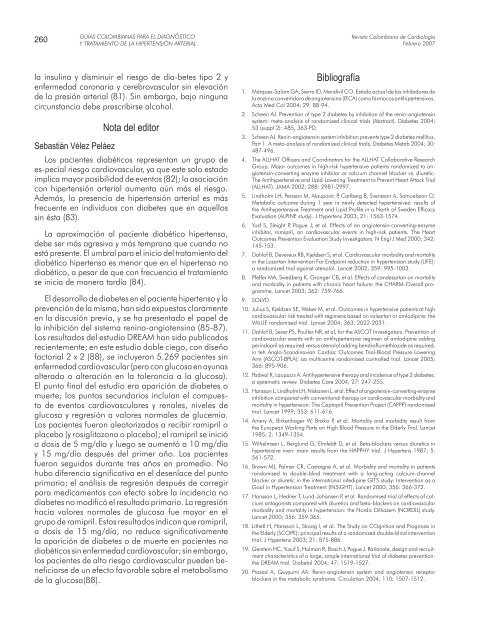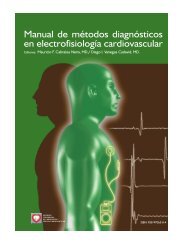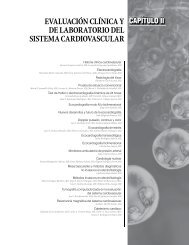GUIAS HIPERTENSION ARTERIAL.indb - Scc
GUIAS HIPERTENSION ARTERIAL.indb - Scc
GUIAS HIPERTENSION ARTERIAL.indb - Scc
You also want an ePaper? Increase the reach of your titles
YUMPU automatically turns print PDFs into web optimized ePapers that Google loves.
260<br />
GUÍAS COLOMBIANAS PARA EL DIAGNÓSTICO<br />
Y TRATAMIENTO DE LA HIPERTENSIÓN <strong>ARTERIAL</strong><br />
la insulina y disminuir el riesgo de dia-betes tipo 2 y<br />
enfermedad coronaria y cerebrovascular sin elevación<br />
de la presión arterial (81). Sin embargo, bajo ninguna<br />
circunstancia debe prescribirse alcohol.<br />
Nota del editor<br />
Sebastián Vélez Peláez<br />
Los pacientes diabéticos representan un grupo de<br />
es-pecial riesgo cardiovascular, ya que este solo estado<br />
implica mayor posibilidad de eventos (82); la asociación<br />
con hipertensión arterial aumenta aún más el riesgo.<br />
Además, la presencia de hipertensión arterial es más<br />
frecuente en individuos con diabetes que en aquellos<br />
sin ésta (83).<br />
La aproximación al paciente diabético hipertenso,<br />
debe ser más agresiva y más temprana que cuando no<br />
está presente. El umbral para el inicio del tratamiento del<br />
diabético hipertenso es menor que en el hipertenso no<br />
diabético, a pesar de que con frecuencia el tratamiento<br />
se inicia de manera tardía (84).<br />
El desarrollo de diabetes en el paciente hipertenso y la<br />
prevención de la misma, han sido expuestas claramente<br />
en la discusión previa, y se ha presentado el papel de<br />
la inhibición del sistema renina-angiotensina (85-87).<br />
Los resultados del estudio DREAM han sido publicados<br />
recientemente; en este estudio doble ciego, con diseño<br />
factorial 2 x 2 (88), se incluyeron 5.269 pacientes sin<br />
enfermedad cardiovascular (pero con glucosa en ayunas<br />
alterada o alteración en la tolerancia a la glucosa).<br />
El punto final del estudio era aparición de diabetes o<br />
muerte; los puntos secundarios incluían el compuesto<br />
de eventos cardiovasculares y renales, niveles de<br />
glucosa y regresión a valores normales de glucemia.<br />
Los pacientes fueron aleatorizados a recibir ramipril o<br />
placebo (y rosiglitazona o placebo); el ramipril se inició<br />
a dosis de 5 mg/día y luego se aumentó a 10 mg/día<br />
y 15 mg/día después del primer año. Los pacientes<br />
fueron seguidos durante tres años en promedio. No<br />
hubo diferencia significativa en el desenlace del punto<br />
primario; el análisis de regresión después de corregir<br />
para medicamentos con efecto sobre la incidencia no<br />
diabetes no modificó el resultado primario. La regresión<br />
hacia valores normales de glucosa fue mayor en el<br />
grupo de ramipril. Estos resultados indican que ramipril,<br />
a dosis de 15 mg/día, no reduce significativamente<br />
la aparición de diabetes o de muerte en pacientes no<br />
diabéticos sin enfermedad cardiovascular; sin embargo,<br />
los pacientes de alto riesgo cardiovascular pueden beneficiarse<br />
de un efecto favorable sobre el metabolismo<br />
de la glucosa(88).<br />
Bibliografía<br />
Revista Colombiana de Cardiología<br />
Febrero 2007<br />
1. Márquez-Salom GA, Sierra ID, Mendivil CO. Estado actual de los inhibidores de<br />
la enzima convertidora de angiotensina (IECA) como fármacos antihipertensivos.<br />
Acta Med Col 2004; 29: 88-94.<br />
2. Scheen AJ. Prevention of type 2 diabetes by inhibition of the renin-angiotensin<br />
system: meta-analysis of randomized clinical trials (Abstract). Diabetes 2004;<br />
53 (suppl 2): A85, 363-PD.<br />
3. Scheen AJ. Renin-angiotensin system inhibition prevents type 2 diabetes mellitus.<br />
Part 1. A meta-analysis of randomized clinical trials. Diabetes Metab 2004; 30:<br />
487-496.<br />
4. The ALLHAT Officers and Coordinators for the ALLHAT Collaborative Research<br />
Group. Major outcomes in high-risk hypertensive patients randomized to angiotensin-converting<br />
enzyme inhibitor or calcium channel blocker vs. diuretic.<br />
The Antihypertensive and Lipid-Lowering Treatment to Prevent Heart Attack Trial<br />
(ALLHAT). JAMA 2002; 288: 2981-2997.<br />
5. Lindholm LH, Persson M, Alaupovic P, Carlberg B, Svensson A, Samuelsson O.<br />
Metabolic outcome during 1 year in newly detected hypertensives: results of<br />
the Antihypertensive Treatment and Lipid Profile in a North of Sweden Efficacy<br />
Evaluation (ALPINE study). J Hypertens 2003; 21: 1563-1574.<br />
6. Yusf S, Sleight P, Pogue J, et al. Effects of an angiotensin-converting-enzyme<br />
inhibitor, ramipril, on cardiovascular events in high-risk patients. The Heart<br />
Outcomes Prevention Evaluation Study Investigators. N Engl J Med 2000; 342:<br />
145-153.<br />
7. Dahlof B, Devereux RB, Kjeldsen S, et al. Cardiovascular morbidity and mortality<br />
in the Losartan Intervention For Endpoint reduction in hypertension study (LIFE):<br />
a randomized trial against atenolol. Lancet 2002; 359: 995-1003.<br />
8. Pfeffer MA, Swedberg K, Granger CB, et al. Effects of candesartan on mortality<br />
and morbidity in patients with chronic heart failure: the CHARM-Overall programme.<br />
Lancet 2003; 362: 759-766.<br />
9. SOLVD.<br />
10. Julius S, Kjeldsen SE, Weber M, et al. Outcomes in hypertensive patients at high<br />
cardiovascular risk treated with regimens based on valsartan or amlodipine: the<br />
VALUE randomised trial. Lancet 2004; 363: 2022-2031.<br />
11. Dahlof B, Sever PS, Poulter NR, et al, for the ASCOT Investigators. Prevention of<br />
cardiovascular events with an antihypertensive regimen of amlodipine adding<br />
perindopril as required versus atenolol adding bendroflumethiazide as required,<br />
in teh Anglo-Scandinavian Cardiac Outcomes Trial-Blood Pressure Lowering<br />
Arm (ASCOT-BPLA): aa multicentre randomised controlled trial. Lancet 2005;<br />
366: 895-906.<br />
12. Padwal R, Laupacis A. Antihypertensive therapy and incidence of type 2 diabetes:<br />
a systematic review. Diabetes Care 2004; 27: 247-255.<br />
13. Hansson L, Lindholm LH, Niskanen L, et al. Effect of angiotensin-converting-enzyme<br />
inhibition compared with conventional therapy on cardiovascular morbidity and<br />
mortality in hypertension: The Captopril Prevention Project (CAPPP) randomised<br />
trial. Lancet 1999; 353: 611-616.<br />
14. Amery A, Birkenhager W, Brixko P, et al. Mortality and morbidity result from<br />
the European Working Party on High Blood Pressure in the Elderly Trial. Lancet<br />
1985; 2: 1349-1354.<br />
15. Wilhelmsen L, Berglund G, Elmfeldt D, et al. Beta-blockers versus diuretics in<br />
hypertensive men: main results from the HAPPHY trial. J Hypertens 1987; 5:<br />
561-572.<br />
16. Brown MJ, Palmer CR, Castaigne A, et al. Morbidity and mortality in patients<br />
randomised to double-blind treatment with a long-acting calcium-channel<br />
blocker or diuretic in the international nifedipine GITS study: Intervention as a<br />
Goal in Hypertension Treatment (INSIGHT). Lancet 2000; 356: 366-372.<br />
17. Hansson L, Hedner T, Lund-Johansen P, et al. Randomised trial of effects of calcium<br />
antagonists compared with diuretics and beta-blockers on cardiovascular<br />
morbidity and mortality in hypertension: the Nordic Diltiazem (NORDIL) study.<br />
Lancet 2000; 356: 359-365.<br />
18. Lithell H, Hansson L, Skoog I, et al. The Study on COgnition and Prognosis in<br />
the Elderly (SCOPE): principal results of a randomized double-blind intervention<br />
trial. J Hypertens 2003; 21: 875-886.<br />
19. Gerstein HC, Yusuf S, Holman R, Bosch J, Pogue J. Rationale, design and recruitment<br />
characteristics of a large, simple international trial of diabetes prevention:<br />
the DREAM trial. Diabetol 2004; 47: 1519-1527.<br />
20. Prasad A, Quyyumi AA. Renin-angiotensin system and angiotensin receptor<br />
blockers in the metabolic syndrome. Circulation 2004; 110: 1507-1512.




